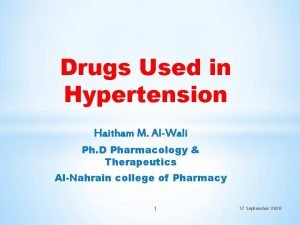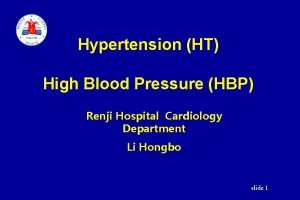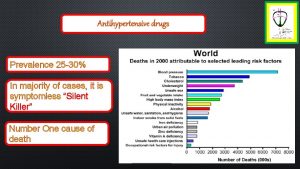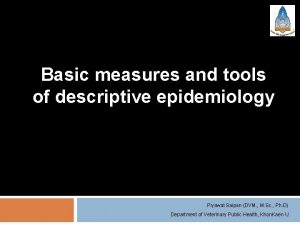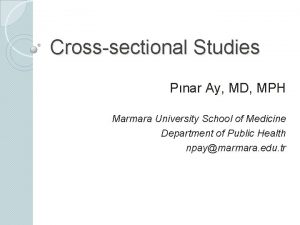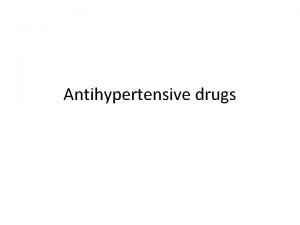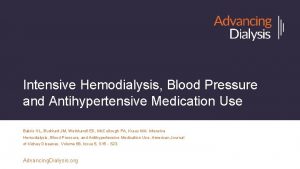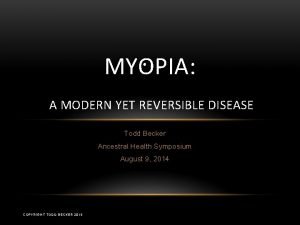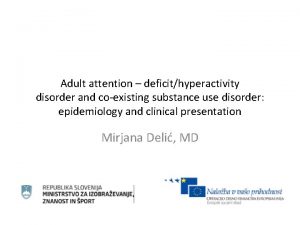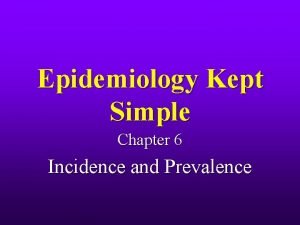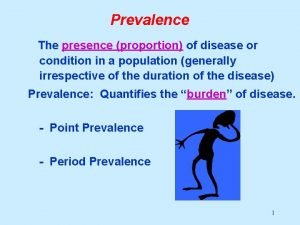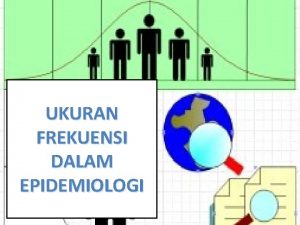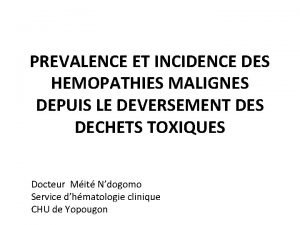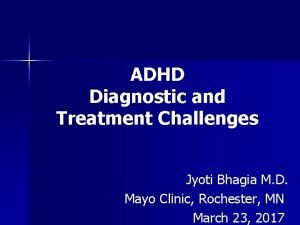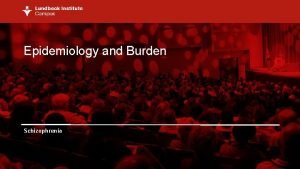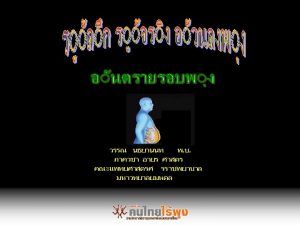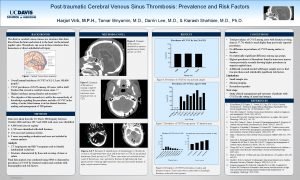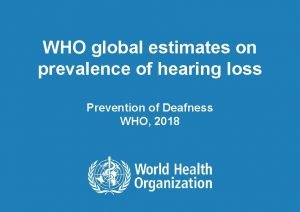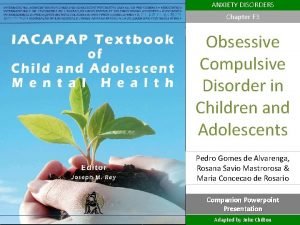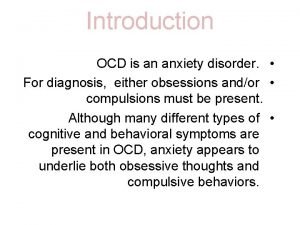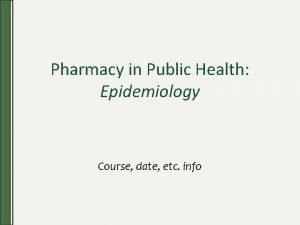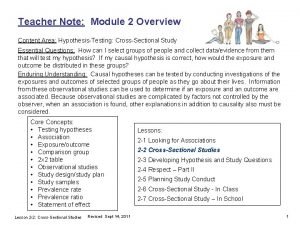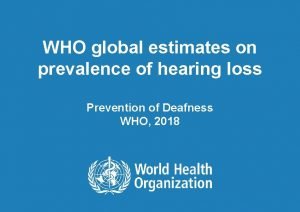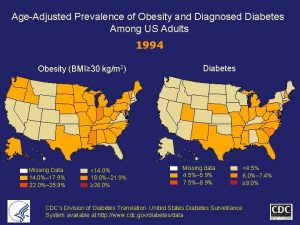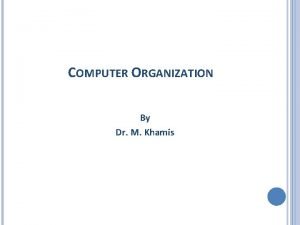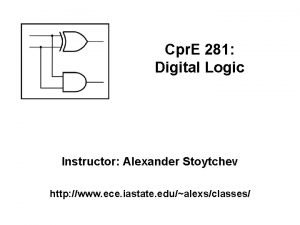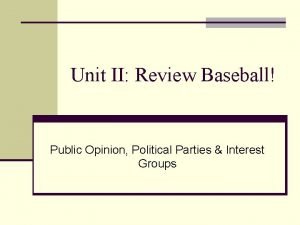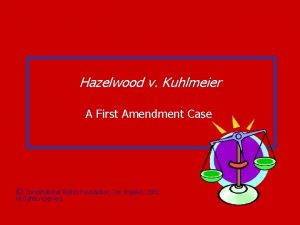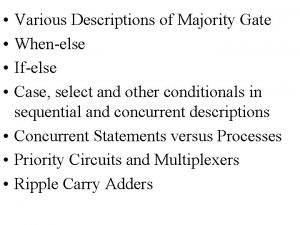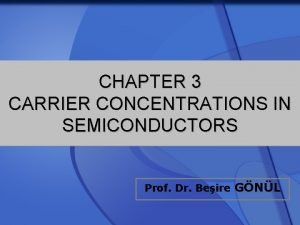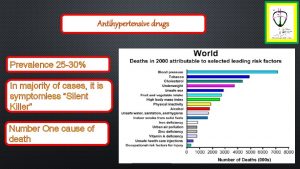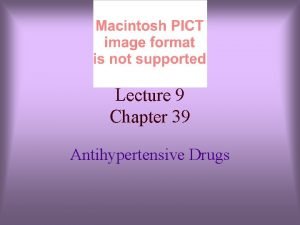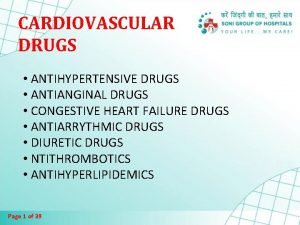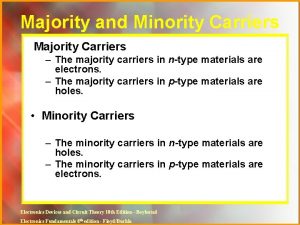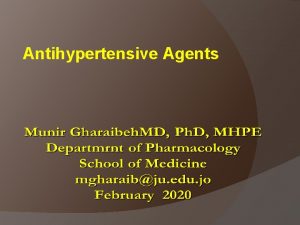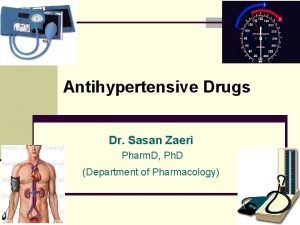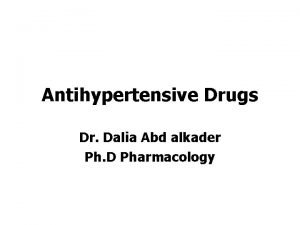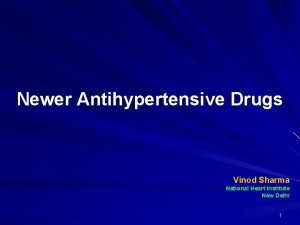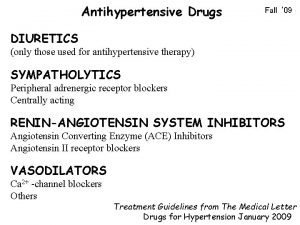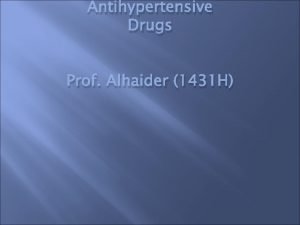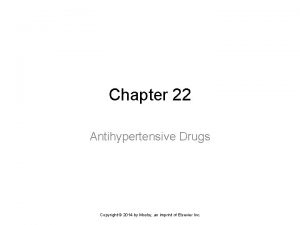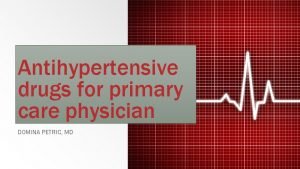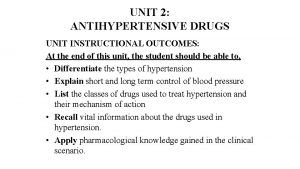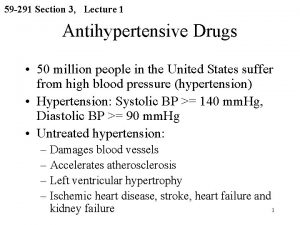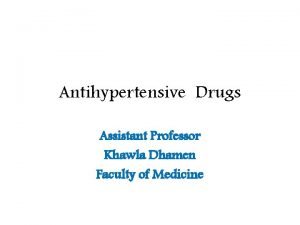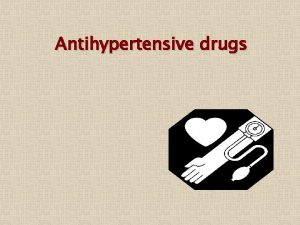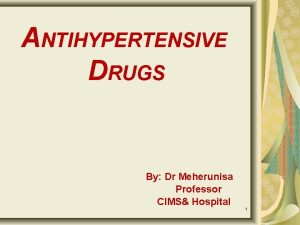Antihypertensive drugs Prevalence 25 30 In majority of



















































- Slides: 51

Antihypertensive drugs Prevalence 25 -30% In majority of cases, it is symptomless “Silent Killer” Number One cause of death

The rule of halves of Hypertension • For every 800 adults in the community • 400 are hypertensive (either ↑ SBP or ↑ DBP or both) • Of them only 200 are diagnosed HT • Of them only 100 are started on treatment • Of them only 50 are on correct drug • Of them in only 25 the goal B. P. is attained • Means 25 ÷ 400 = 6% only have goal BP

Antihypertensive drugs ILOS Outline the pharmacologic classes of drugs used in treatment of hypertension Describe the mechanism of action , therapeutic uses & common adverse effects of each class of drugs Select an antihypertensive drug to treat a specific patient according to efficacy, safety, suitability & cost

Antihypertensive drugs Interactive Lecture Segments 1 -Minicase 2 -Q & A 3 -Think-pair-share 5 -Task-Selection of a Pdrug 6 -Memory matrix

Clinical case Osman a 51 -year-old man (95 Kg weight, 176 cm tall) is referred for further evaluation of his BP. He is a computer engineer and has a past history of type 2 diabetes for 5 years and high BP for 12 years. His somatic complaints include fatigue and dry mouth. He has no known history of hypertension target-organ damage, and his medications are listed in the accompanying table. He has no remarkable family history other than hypertension in both parents. His seated BP was 156/90 mm. Hg and 158/90 mm. Hg in the right arm (similar to the left arm), with a regular heart rate of 70 beats/min. His BP did not change on standing. His urinalysis showed an unremarkable dipstick evaluation. The patient was suspected as having drug- resistant hypertension. Name Dose Hydrochlorothiazide 25 mg Frequen cy Daily Valsartan 160 mg Daily Diltiazem, longacting 300 mg Daily Clonidine 0. 2 mg Metoprolol, long acting 100 mg daily Simvastatin 40 mg Fenofibrate 145 mg Daily Metformin 1 g Twice daily Daily Twice daily

Clinical case List as many reasons as you can, why Osman failed to respond to antihypertensive therapy

Clinical case The seated BP of Osman was 156/90, what are the target BP values for treatment of hypertensive patients? What stage of hypertension is Osman? Osman is diabetic, what are the target BP values for a diabetic patient?

Clinical case Osman has no history of hypertensiontarget organ damage. What are organs affected adversely by persistent high BP? Osman is 95 kg big. Is this weight proper for his length(176 cm)? If Osman has to reduce his body weight, what other lifestyle modifications should he do?

Antihypertensive drugs classification 1 -Diuretics 2 -Drugs acting on the renin-angiotensinaldosterone system 3 -Calcium channel blockers 4 -Vasodilators 5 -Drugs acting on sympathetic nervous system

Antihypertensive drugs Diuretics Thiazide diuretics Hydrochlorothiazide , chlorthalidone & furosemide Mechanism of action e -t rm ini t ial ng o L sodium, water retention Na+ in vessel wall Na+-Ca 2+ exchange blood volume Ca 2+ in smooth muscle cell The intial diuresis lasts 4 -6 weeks and then replaced by a decrease in PVR Cardiac outrput Peripheral resistance Decrease in BP

diuretics Loop diuretics produce more potent diuresis but a smaller decrease in PVR Loop diuretics are useful in hypertensive patients with either renal impairment, or heart failure Potassium- sparing diuretics have minimal effect on lowering BP Diuretics may be adequate in mild to moderate hypertension According to ALLHAT, chlorthalidone is superior to an ACE inhibitor, a calcium channel blocker and an alpha 1 -adrenergic antagonist in preventing one or more CVD events.

Clinical case Could the “white coat phenomenon” be the cause for Osman’s high blood pressure readings? In a Turkish study involving 438 patients, 43% were found to be white coat hypertensives

Clinical case Could the failure of control of Osman BP be due to secondary drug – induced effects? Which drugs elevate blood pressure?

Clinical case Could Osman be misdiagnosed? And the high BP is due to secondary disease causes? Which secondary diseases cause elevation of BP?

Antihypertensive drugs ii- Drugs acting on the renin- angiotensin - aldosterone system 1 - Angiotensin-converting enzyme inhibitors (ACEI) Captopril Lisinopril Enalapril Ramipril 2 -Angiotensin receptors blockers

Antihypertensive drugs 1 - Angiotensin-converting enzyme inhibitors (ACEI) Particularly effective when hypertension results from excess renin production (renovascular hypertension, white & young) Ø The antihypertensive effect of ACE inhibitors results primarily from vasodilatation (reduction of peripheral resistance) with little change on cardiac output. Ø A fall in aldosterone production may also

1 - Angiotensin-converting enzyme inhibitors pharmacokinetics Polar, excreted in urine Have a long half-life & given once daily Do not cross BBB Enalapril & ramipril are prodrugs Rapidly absorbed from GIT after oral administration Food reduces their bioavailability It takes 2 -4 weeks to see the full antihypertensive effect of ACIs Enalaprilat is the active metabolite of enalapril given by i. v. route in hypertensive emergency

1 - Angiotensin-converting enzyme inhibitors Clinical uses 1 -Treatment of essential hypertension 2 -Hypertension in patients with chronic renal disease, ischemic heart disease, diabetes 3 -Treatment of heart failure

1 - Angiotensin-converting enzyme inhibitors adrs Dry cough Acute renal failure, especially in patients with bilateral renal artery stenosis Severe hypotension in hypovolemic patients Cause renal agensia/failure in the fetus, resulting in oligohydraminosis

1 - Angiotensin-converting enzyme inhibitors adrs Angioneurotic edema, swelling in the nose , throat, tongue, larynx First dose effect adrs specific to captopril Skin rash, fever Dysgeusia Proteinuria and neutropenia

1 - Angiotensin-converting enzyme inhibitors contraindications During the second and third trimesters of pregnancy due to the risk of : fetal hypotension , anuria , renal failure & malformations Bilateral renal artery stenosis Potassium-sparing diuretics NSAIDs

2 -Angiotensin receptors blockers Losartan Valsartan Cause selective block of AT 1 receptors No effect on bradykinin, no cough, no angioedema Produce more complete inhibition of angiotensin

2 -Angiotensin receptors blockers losartan Has a potent active metabolite Orally effective Long half-life, taken once daily Do not cross BBB valsartan Same contraindications as ACEI No active metabolites Same ADRs, except for dry cough & angioneurotic edema

Clinical case Osman was prescribed hydrochlorthiazide & valsartan. What is the rationale for combining hydrochlorothiazide and valsartan?

Think- pair-share The brachial artery was continuously infused with bradykinin and the blood flow is monitored. Placebo, drug A and drug B (both affect the RAAS) induced the effects on blood flow shown in the graph. What is drug A? Justify! What is drug B? Justify!

Antihypertensive drugs 3 -Calcium channel blockers Verapamil act more on the myocardium Dihydropyridine group act mainly on smooth muscle, Nifedipine Diltiazem has intermediate effect V ery N ice D rugs

Calcium channel blockers Mechanism Block the influx of calcium through calcium channels resulting in: - 1 - Peripheral vasodilatation 2 - Decrease cardiac contractility

Calcium channel blockers pharmacokinetics Given orally or IV Well absorbed Onset 1 -3 min after IV, 0. 5 -2 hr after oral Verapamil & diltiazem have active metabolites, nifedipine has not Verapamil and nifedipine are highly bound to plasma proteins ( more than 90%) while diltiazem is less ( 70 -80%)

Calcium channel blockers Clinical uses Treatment of chronic hypertension Nicardipine can be given by I. V. route in hypertensive emergency Sustained- release formulations are preferred for the treatment of hypertension due to the short half- life of CCBs

Antihypertensive drugs adrs Headache , Flushing , Hypotension Nifedipine: -Tachycardia Verapamil & Diltiazem: - peripheral edema (ankle edema) Verapamil: - constipation

Clinical case Osman was prescribed hydrochlorothiazide & diltiazem. What is the benefit of combining hydrochlorothiazide and diltiazem?

Clinical case The BP of Osman was almost the same in both arms. What does that imply?

Task- Selection of a p-drug Instructions: 1 - Select a leader for your group 2 - Discuss the case according to the steps shown in the sheet 3 - Use your internet access to obtain evidence for efficacy, toxicity, convenience & cost. 4 - Due to time constrains divide yourself into 4 groups, each doing one search e. g. evidence for efficacy. 5 - You have 10 minutes to do this and 1 minute to report to the class.

Antihypertensive drugs 4 - vasodilators Classified into arterial, venous or mixed vasodilators Once vasodilators are administered, fall in BP produced will activate the sympathetic system & the RAAS

Antihypertensive drugs vasodilators Hydralazine Minoxidil Diazoxide Site of action Arteriodilator Mechanism of action Opening of potassium Opening of channels in smooth potassium muscle membranes by channels minoxidil sulfate ( active metabolite ) Route of admin. Direct Oral Arteriodilator Rapid intravenous Sodium nitropruside Arterio & venodilator Release of nitric oxide ( NO) Intravenous infusion

vasodilators Continue Vasodilators Hydralazine 1. Moderate severe hypertension. Therapeutic uses Minoxidil 1. Moderate – severe hypertension Diazoxide 1. Hypertensive emergency Sodium nitropruside 1. Hpertensive emergency In combination with diuretic & β-blockers 2. Hypertensive pregnant woman 2. baldness 2. Treatment of hypoglycemia due to insulinoma 2. Severe heart failure

vasodilators Continue Vasodilators Hydralazine Minoxidil Diazoxide Sodium nitropruside Hypotension, reflex tachycardia, palpitation, angina, salt and water retention ( edema) Severe hypotension lupus erythematosus like syndrome 1. Methemoglobindu ring infusion 2. Cyanide toxicity 3. Thiocyanate toxicity Adverse effects Specific adverse effects Hypertrichosis. Inhibit insulin release from β cells of the pancreas causing hyperglycemia Contraindicated in diabetics females

vasodilators Sodium nitroprusside adrs Headache, palpitations which disappear when infusion is stopped Cyanide accumulation cause cyanide poisoning (metabolic acidosis, arrhythmias, severe hypotension and death)

5 -Sympatholytic Drugs i-ß Adrenoceptor blockers Propranolol, atenolol, metoprolol They should not be the primary agent for primary prevention but are effective as add-on therapy May take two weeks for optimal therapeutic response Evidence support the use of ß-blockers in patients with concomitant coronary artery disease When discontinued, ß- blockers should be withdrawn gradually

ß- Adrenoceptor blockers mechanism They lower blood pressure by : i-Decreasing cardiac output. ii-Inhibiting the release of renin iii- Central mechanism

ß Adrenoceptor blockers ADrs Hypoglycemia Fatigue Mask the symptoms of hypoglycemia in diabetes Increased triglycerides Aggravate peripheral arterial disease Erectile dysfunction

Sympatholytic drugs ii- α Adrenoceptor blockers Block α- receptors in arterioles and venules Reduce blood pressure by decreasing both afterload & preload Prazosin, short- acting causes first dose hypotension & postural hypotension Doxazosin, is preferred →long half- life

Clinical case The BP of Osman did not change on standing. What is your conclusion?

Iii- Centrally- acting A- Clonidine α 2 -agonist, diminishes central adrenergic outflow & ↑ parasympathetic outflow Abrupt withdrawal may lead to rebound hypertension Does not decrease renal blood flow or glomerular filtration Useful in the treatment of hypertension complicated by renal disease and resistant hypertension

Sympatholytic drugs Centrally- acting B- α- methyldopa An α- 2 agonist, is converted to methyl noradrenaline centrally to diminish the adrenergic outflow from the C. N. S Lead to reduced total peripheral resistance, and a decreased in blood pressure α -Methyldopa is the first line treatment of hypertension in pregnancy

Clinical case Is the concomitant prescribing of clonidine, diltiazem and metoprolol to Osman rational?

Clinical case Could the failure of Osman control of BP be due to the use of inappropriate combinations of drugs? Use of combinations→↓ individual dose→↓ ADRs Select a drug that ↓ the ADR of another, e. g. thiazides versus ACEI Select a drugs that act by different mechanisms

Clinical case Could the failure of control of Osman’s BP be attributed to non adherence? Could the somatic complaints (fatigue and dry mouth) indicate the adherence of Osman to medication regimen and which drugs cause these symptoms?

Memory matrix Enter + or – in the cells to indicate the presence or absence of a feature Compelling contraindications of antihypertensive drugs HF Diuretics ACEI CCB ß-blockers ARB Pregnancy Hypokalemia Bradycardia Asthma Hyperkalemia Gout

Control of blood pressure & site of drug action

Antihypertensive drugs
 Classification of antihypertensive drugs with examples
Classification of antihypertensive drugs with examples Antihypertensive drugs classification
Antihypertensive drugs classification Antihypertensive drugs
Antihypertensive drugs Blood pressure medication dosage chart
Blood pressure medication dosage chart Antihypertensive drugs classification
Antihypertensive drugs classification Period prevalence vs point prevalence
Period prevalence vs point prevalence Period prevalence vs point prevalence
Period prevalence vs point prevalence Defination of proportion
Defination of proportion Period prevalence vs point prevalence
Period prevalence vs point prevalence Antihypertensive drug classification
Antihypertensive drug classification Antihypertensive
Antihypertensive Zennioptical.com
Zennioptical.com Descriptive vs analytic epidemiology examples
Descriptive vs analytic epidemiology examples Prevalence calculation
Prevalence calculation Calculate relative risk
Calculate relative risk Adhd prevalence by country
Adhd prevalence by country Incidence vs incidence rate
Incidence vs incidence rate Prevalence
Prevalence Epidemiologi adalah
Epidemiologi adalah Prevalence
Prevalence Calculate prevalence rate
Calculate prevalence rate Prevented fraction
Prevented fraction Adhd prevalence by country
Adhd prevalence by country Prevalence of schizophrenia
Prevalence of schizophrenia Prevalence of obesity
Prevalence of obesity Obesity prevalence europe
Obesity prevalence europe Cerebral venous sinus thrombosis prevalence
Cerebral venous sinus thrombosis prevalence Who global estimates on prevalence of hearing loss 2020
Who global estimates on prevalence of hearing loss 2020 Ocd vs anxiety
Ocd vs anxiety Syntonic vs dystonic
Syntonic vs dystonic Perbedaan or rr dan pr
Perbedaan or rr dan pr Cross sectional study
Cross sectional study Calculate prevalence rate
Calculate prevalence rate Prevalence ratio
Prevalence ratio Prevalence
Prevalence Who global estimates on prevalence of hearing loss 2020
Who global estimates on prevalence of hearing loss 2020 Age adjusted prevalence
Age adjusted prevalence Point and period prevalence
Point and period prevalence Cara hitung insiden rate
Cara hitung insiden rate Is a reaction to vague or imagined dangers
Is a reaction to vague or imagined dangers Majority circuit
Majority circuit Majority vote circuit
Majority vote circuit Three input majority function
Three input majority function Behaviours that enable a minority to influence a majority
Behaviours that enable a minority to influence a majority Which of the following
Which of the following Majority-minority districts definition ap human geography
Majority-minority districts definition ap human geography Shannon's expansion theorem example
Shannon's expansion theorem example The term “minority majority” refers to the fact that
The term “minority majority” refers to the fact that Majority
Majority Hazelwood vs kuhlmeier amendment
Hazelwood vs kuhlmeier amendment Majority gate
Majority gate Fermi level in semiconductor
Fermi level in semiconductor
